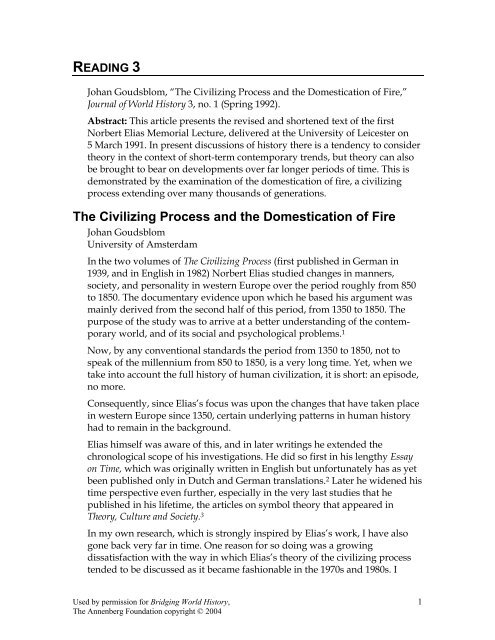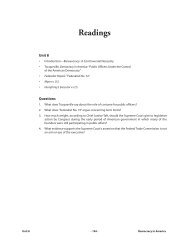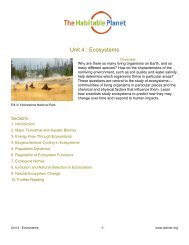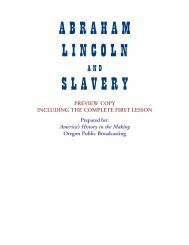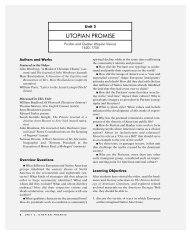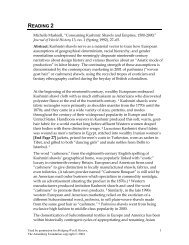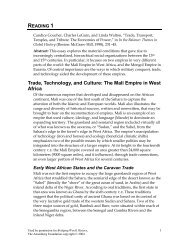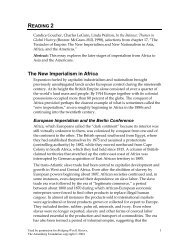The Civilizing Process and the Domestication of Fire
The Civilizing Process and the Domestication of Fire
The Civilizing Process and the Domestication of Fire
Create successful ePaper yourself
Turn your PDF publications into a flip-book with our unique Google optimized e-Paper software.
READING 3<br />
Johan Goudsblom, “<strong>The</strong> <strong>Civilizing</strong> <strong>Process</strong> <strong>and</strong> <strong>the</strong> <strong>Domestication</strong> <strong>of</strong> <strong>Fire</strong>,”<br />
Journal <strong>of</strong> World History 3, no. 1 (Spring 1992).<br />
Abstract: This article presents <strong>the</strong> revised <strong>and</strong> shortened text <strong>of</strong> <strong>the</strong> first<br />
Norbert Elias Memorial Lecture, delivered at <strong>the</strong> University <strong>of</strong> Leicester on<br />
5 March 1991. In present discussions <strong>of</strong> history <strong>the</strong>re is a tendency to consider<br />
<strong>the</strong>ory in <strong>the</strong> context <strong>of</strong> short-term contemporary trends, but <strong>the</strong>ory can also<br />
be brought to bear on developments over far longer periods <strong>of</strong> time. This is<br />
demonstrated by <strong>the</strong> examination <strong>of</strong> <strong>the</strong> domestication <strong>of</strong> fire, a civilizing<br />
process extending over many thous<strong>and</strong>s <strong>of</strong> generations.<br />
<strong>The</strong> <strong>Civilizing</strong> <strong>Process</strong> <strong>and</strong> <strong>the</strong> <strong>Domestication</strong> <strong>of</strong> <strong>Fire</strong><br />
Johan Goudsblom<br />
University <strong>of</strong> Amsterdam<br />
In <strong>the</strong> two volumes <strong>of</strong> <strong>The</strong> <strong>Civilizing</strong> <strong>Process</strong> (first published in German in<br />
1939, <strong>and</strong> in English in 1982) Norbert Elias studied changes in manners,<br />
society, <strong>and</strong> personality in western Europe over <strong>the</strong> period roughly from 850<br />
to 1850. <strong>The</strong> documentary evidence upon which he based his argument was<br />
mainly derived from <strong>the</strong> second half <strong>of</strong> this period, from 1350 to 1850. <strong>The</strong><br />
purpose <strong>of</strong> <strong>the</strong> study was to arrive at a better underst<strong>and</strong>ing <strong>of</strong> <strong>the</strong> contemporary<br />
world, <strong>and</strong> <strong>of</strong> its social <strong>and</strong> psychological problems. 1<br />
Now, by any conventional st<strong>and</strong>ards <strong>the</strong> period from 1350 to 1850, not to<br />
speak <strong>of</strong> <strong>the</strong> millennium from 850 to 1850, is a very long time. Yet, when we<br />
take into account <strong>the</strong> full history <strong>of</strong> human civilization, it is short: an episode,<br />
no more.<br />
Consequently, since Elias’s focus was upon <strong>the</strong> changes that have taken place<br />
in western Europe since 1350, certain underlying patterns in human history<br />
had to remain in <strong>the</strong> background.<br />
Elias himself was aware <strong>of</strong> this, <strong>and</strong> in later writings he extended <strong>the</strong><br />
chronological scope <strong>of</strong> his investigations. He did so first in his lengthy Essay<br />
on Time, which was originally written in English but unfortunately has as yet<br />
been published only in Dutch <strong>and</strong> German translations. 2 Later he widened his<br />
time perspective even fur<strong>the</strong>r, especially in <strong>the</strong> very last studies that he<br />
published in his lifetime, <strong>the</strong> articles on symbol <strong>the</strong>ory that appeared in<br />
<strong>The</strong>ory, Culture <strong>and</strong> Society. 3<br />
In my own research, which is strongly inspired by Elias’s work, I have also<br />
gone back very far in time. One reason for so doing was a growing<br />
dissatisfaction with <strong>the</strong> way in which Elias’s <strong>the</strong>ory <strong>of</strong> <strong>the</strong> civilizing process<br />
tended to be discussed as it became fashionable in <strong>the</strong> 1970s <strong>and</strong> 1980s. I<br />
Used by permission for Bridging World History, 1<br />
<strong>The</strong> Annenberg Foundation copyright © 2004
found that many <strong>of</strong> those discussions were focused too narrowly on current<br />
trends. Of course, those trends are <strong>of</strong> immediate concern to us, <strong>and</strong> <strong>the</strong>y need<br />
to be investigated. But <strong>the</strong>re is more to <strong>the</strong> civilizing process than what is<br />
happening today.<br />
To broaden <strong>the</strong> perspective <strong>and</strong> to clarify <strong>the</strong> issue, I have found it useful,<br />
first <strong>of</strong> all, to make a rough systematic classification. It is convenient, I think,<br />
to distinguish between three levels at which we may speak <strong>of</strong> a civilizing<br />
process.<br />
First <strong>of</strong> all, <strong>the</strong>re is <strong>the</strong> level <strong>of</strong> <strong>the</strong> individual. Each person is born with <strong>the</strong><br />
capacity <strong>and</strong> <strong>the</strong> need to learn. He has to learn to interpret <strong>the</strong> sense<br />
impressions that reach him from <strong>the</strong> outside world as well as <strong>the</strong> inner<br />
impulses that arise within. (I regret having to use <strong>the</strong> masculine form, which<br />
appears to ignore more than half <strong>of</strong> humankind, but I also find it slightly<br />
pedantic <strong>and</strong> inelegant always to utter <strong>the</strong> obligatory “he or she.” So I hope I<br />
may be forgiven for occasionally committing this linguistic discourtesy. I<br />
should like to point out in passing that our increasing sensitivity in such<br />
matters typically represents a small step in <strong>the</strong> civilizing process, reflecting a<br />
change in <strong>the</strong> balance <strong>of</strong> power between men <strong>and</strong> women.)<br />
When a child gradually acquires a certain measure <strong>of</strong> self-control, a way <strong>of</strong><br />
regulating its own impressions <strong>and</strong> impulses, this may be regarded as a<br />
civilizing process at <strong>the</strong> individual level. In <strong>the</strong> course <strong>of</strong> it, <strong>the</strong> child learns to<br />
live according to <strong>the</strong> st<strong>and</strong>ards <strong>of</strong> conduct prevailing in <strong>the</strong> society <strong>and</strong> social<br />
groups in which it grows up.<br />
Now, <strong>the</strong> st<strong>and</strong>ards <strong>of</strong> conduct prevailing in any society at any given time are<br />
not eternally unchanging. Even if some <strong>of</strong> <strong>the</strong>m are given justification by<br />
religious texts that claim eternal validity, <strong>the</strong>se texts <strong>the</strong>mselves are never<br />
older than a few thous<strong>and</strong> years at most.<br />
We may <strong>the</strong>refore conclude that <strong>the</strong> social norms that individuals acquire by<br />
learning are <strong>the</strong>mselves <strong>the</strong> result <strong>of</strong> historical processes—or, to stick to<br />
Elias’s terminology, <strong>of</strong> civilizing processes, extending over many generations.<br />
This would be <strong>the</strong> second level in my classification: sociocultural processes by<br />
means <strong>of</strong> which st<strong>and</strong>ards <strong>of</strong> conduct are h<strong>and</strong>ed down from one generation<br />
to <strong>the</strong> next, <strong>and</strong> in <strong>the</strong> course <strong>of</strong> which <strong>the</strong>se st<strong>and</strong>ards may also change,<br />
rapidly or slowly, as <strong>the</strong> case may be. Elias’s study <strong>of</strong> <strong>the</strong> civilizing process in<br />
western Europe in <strong>the</strong> early modern era is focused upon this second level.<br />
But, as Elias himself notes at several places in his book, <strong>the</strong> civilizing process<br />
in western Europe did not start from scratch. No matter how far back we go<br />
into <strong>the</strong> early Middle Ages, nowhere do we meet a pristine stage <strong>of</strong> people<br />
living entirely without st<strong>and</strong>ards <strong>of</strong> conduct learned by children from <strong>the</strong>ir<br />
elders <strong>and</strong> subsequently passed on to <strong>the</strong>ir own <strong>of</strong>fspring.<br />
Used by permission for Bridging World History, 2<br />
<strong>The</strong> Annenberg Foundation copyright © 2004
<strong>The</strong>re is, in o<strong>the</strong>r words, no “zero point” in <strong>the</strong> European civilizing process. It<br />
formed <strong>the</strong> continuation, in its own way, <strong>of</strong> earlier civilizing processes—<br />
among <strong>the</strong> Greeks, <strong>the</strong> Romans, <strong>the</strong> Celts, <strong>the</strong> Germanic peoples, <strong>and</strong> so on.<br />
Nor had <strong>the</strong>se earlier societies started from scratch. <strong>The</strong>y all carried on (again,<br />
each in its own unique way) more ancient traditions, formed at earlier stages.<br />
Human history <strong>of</strong>fers no example <strong>of</strong> an entirely normless group, or <strong>of</strong> a<br />
completely “uncivilized” society.<br />
Following this line <strong>of</strong> thought we arrive at <strong>the</strong> inevitable conclusion that <strong>the</strong>re<br />
is a third level at which a civilizing process may be discerned: <strong>the</strong> level <strong>of</strong><br />
human history at large. It is worth examining whe<strong>the</strong>r Elias’s <strong>the</strong>ory may be<br />
applied to this third level, which encompasses both <strong>the</strong> second (<strong>the</strong> societal)<br />
<strong>and</strong> <strong>the</strong> first (<strong>the</strong> individual).<br />
Here is where fire comes in. For <strong>the</strong> control <strong>of</strong> fire is an integral aspect <strong>of</strong><br />
human life, undeniably involving foresight <strong>and</strong> renunciation <strong>of</strong> primary<br />
impulses, which has been in existence not just for one or two generations, <strong>and</strong><br />
not even for ten to twenty generations, but for many thous<strong>and</strong>s <strong>of</strong><br />
generations.<br />
As I delved into <strong>the</strong> subject, I became increasingly more convinced that <strong>the</strong><br />
control <strong>of</strong> fire indeed presents an excellent opportunity to test <strong>the</strong> validity <strong>of</strong><br />
<strong>the</strong> <strong>the</strong>ory <strong>of</strong> <strong>the</strong> civilizing process <strong>and</strong> to extend its scope by applying it to<br />
new areas <strong>of</strong> research. 4<br />
It is obviously an element <strong>of</strong> culture—something learned, shared, <strong>and</strong><br />
transmitted. Its history goes back very far into <strong>the</strong> human past. <strong>The</strong> experts<br />
are not yet certain about <strong>the</strong> exact timing <strong>of</strong> <strong>the</strong> earliest traces <strong>of</strong> human or<br />
hominid use <strong>of</strong> fire. But <strong>the</strong>re is general agreement that human societies have<br />
possessed <strong>the</strong> culturally shaped capacity to control fire for at least 400,000<br />
years (that is, more than 10,000 generations), <strong>and</strong> maybe even for as many as<br />
1,400,000 years.<br />
It is a commonly held opinion among contemporary scholars that <strong>the</strong> overall<br />
effects <strong>of</strong> <strong>the</strong> domestication <strong>of</strong> fire did not amount to much in <strong>the</strong> history <strong>of</strong><br />
human society <strong>and</strong> culture. <strong>The</strong>y locate <strong>the</strong> “dawn <strong>of</strong> civilization” only some<br />
10,000 years back, with <strong>the</strong> emergence <strong>of</strong> agriculture, followed by <strong>the</strong> rise <strong>of</strong><br />
cities <strong>and</strong> <strong>the</strong> invention <strong>of</strong> writing. <strong>The</strong> preceding period is loosely described<br />
as “before civilization,” on <strong>the</strong> tacit assumption that humanity must have<br />
been “uncivilized” during by far <strong>the</strong> greater part <strong>of</strong> its existence. 5<br />
I take a different view. <strong>The</strong> domestication <strong>of</strong> fire has had far-reaching<br />
consequences, <strong>and</strong> it deserves to be ranked as <strong>the</strong> first great ecological<br />
transformation brought about by humans, followed very much later by two<br />
transformations <strong>of</strong> <strong>the</strong> same order: <strong>the</strong> emergence <strong>of</strong> agriculture <strong>and</strong> animal<br />
husb<strong>and</strong>ry (agrarianization) some 10,000 years ago, <strong>and</strong> <strong>the</strong> rise <strong>of</strong> large-scale<br />
industrial production (industrialization) some two centuries ago.<br />
Used by permission for Bridging World History, 3<br />
<strong>The</strong> Annenberg Foundation copyright © 2004
* * *<br />
<strong>Fire</strong>—<strong>the</strong> first nonhuman force that was made part <strong>of</strong> human society—is,<br />
according to <strong>the</strong> simplest definition in modern encyclopedias, a process <strong>of</strong><br />
combustion, manifested in heat <strong>and</strong> light. I shall not dwell upon its chemistry,<br />
but merely point to four characteristics that are relevant to our <strong>the</strong>me. First, fire<br />
is destructive. It disintegrates highly organized matter, <strong>and</strong> reduces it to ashes<br />
<strong>and</strong> smoke. Second, it is irreversible. You cannot make <strong>the</strong> ashes return to <strong>the</strong>ir<br />
original shapes <strong>and</strong> colors. <strong>The</strong> phoenix is a bird <strong>of</strong> fantasy. Third, fire has no<br />
purpose. <strong>The</strong> combustion process is blind <strong>and</strong> purposeless. No matter what it<br />
touches, if <strong>the</strong> material is flammable, it will be consumed. Of course, <strong>the</strong><br />
absence <strong>of</strong> purpose is not peculiar to fire. <strong>The</strong> same can be said about o<strong>the</strong>r<br />
natural forces, such as rain or wind. But—<strong>and</strong> this is a fourth characteristic—<br />
fire is self-generating. <strong>Fire</strong> causes heat, <strong>and</strong> heat in turn causes fire.<br />
Destructive, irreversible, purposeless, self-generating—this does not sound<br />
like a very attractive list <strong>of</strong> properties. Why should humans have bo<strong>the</strong>red to<br />
incorporate such a natural force into <strong>the</strong>ir societies?<br />
For us, in retrospect, <strong>the</strong> answer is not difficult. Humans could turn <strong>the</strong><br />
destructive force <strong>of</strong> fire into productive use, <strong>and</strong> thus give it a purpose. <strong>The</strong><br />
fact that fire is self-generating enabled <strong>the</strong>m to preserve <strong>and</strong> reactivate it,<br />
something <strong>the</strong>y could not possibly have done with ei<strong>the</strong>r rain or wind.<br />
<strong>The</strong>re were many ways <strong>of</strong> making fire productive for human purposes. <strong>The</strong><br />
two most elementary, prototypical forms were cooking <strong>and</strong> clearing l<strong>and</strong>. By<br />
cooking, that is, by exposing organic substances to tire without burning <strong>the</strong>m,<br />
people could destroy tough fibers <strong>and</strong> toxic compounds <strong>and</strong> thus make<br />
substances edible <strong>and</strong> palatable that o<strong>the</strong>rwise would not have been fit for<br />
human consumption. Cooking, in o<strong>the</strong>r words, extended <strong>the</strong> range <strong>of</strong> food.<br />
Clearing l<strong>and</strong> by burning <strong>the</strong> vegetation may at first sight seem purely<br />
destructive. It had many advantages, however. It drove animals out <strong>of</strong> <strong>the</strong>ir<br />
shelters, <strong>and</strong> thus facilitated hunting <strong>the</strong>m. It also made <strong>the</strong> l<strong>and</strong> more easily<br />
accessible for some purposes, for example, ga<strong>the</strong>ring nuts <strong>and</strong> fruits that lay<br />
hidden in <strong>the</strong> undergrowth. And it created a fertile <strong>and</strong> unshaded soil in<br />
which, after a while, <strong>the</strong>re would spring up grasses <strong>and</strong> shrubs, which in turn<br />
would attract game.<br />
<strong>The</strong>re were, <strong>of</strong> course, o<strong>the</strong>r advantages as well. As a source <strong>of</strong> heat <strong>and</strong> light,<br />
fire gave protection against cold <strong>and</strong> darkness. It helped to keep predators<br />
<strong>and</strong> o<strong>the</strong>r animals at bay. Because <strong>of</strong> <strong>the</strong> comfort <strong>and</strong> security it <strong>of</strong>fered, it<br />
could be a focus <strong>of</strong> group life <strong>and</strong> enhance communication <strong>and</strong> solidarity. It<br />
was also useful for such practical purposes as sharpening wooden tools or<br />
curbing bones <strong>and</strong> antlers. And it could always serve as a source <strong>of</strong> o<strong>the</strong>r fires<br />
when <strong>the</strong>y were needed.<br />
Used by permission for Bridging World History, 4<br />
<strong>The</strong> Annenberg Foundation copyright © 2004
All <strong>the</strong>se positive effects <strong>of</strong> <strong>the</strong> use <strong>of</strong> fire combined to make human groups<br />
stronger as “survival units,” to use a concept coined by Elias. 6 Adding <strong>the</strong><br />
force <strong>of</strong> fire to <strong>the</strong>ir own strength, <strong>the</strong>se groups could make <strong>the</strong>ir societies<br />
more productive <strong>and</strong> more formidable. <strong>The</strong> increases in productivity,<br />
achieved by more effective hunting as well as by cooking, may initially not<br />
have been great. Yet, in <strong>the</strong> long run, <strong>the</strong>y could not fail to bring about a rise<br />
in <strong>the</strong> st<strong>and</strong>ard <strong>of</strong> material comfort <strong>and</strong> an increase in human numbers, or<br />
what modern economic historians would call, respectively, intensive <strong>and</strong><br />
extensive growth. 7<br />
Intensive growth implied a rise in <strong>the</strong> st<strong>and</strong>ard <strong>of</strong> living (to use ano<strong>the</strong>r<br />
concept from contemporary economics). Just to be able to produce warmth<br />
<strong>and</strong> comfort at will, throughout <strong>the</strong> year, must indeed have meant a great<br />
improvement in living conditions. Even if <strong>the</strong> possession <strong>of</strong> a fire was not<br />
absolutely necessary to endure <strong>the</strong> cold <strong>and</strong> damp winters <strong>of</strong> nor<strong>the</strong>rn<br />
Eurasia, it certainly made <strong>the</strong>se winters more bearable. In this way <strong>the</strong> control<br />
<strong>of</strong> fire also facilitated territorial expansion <strong>and</strong>, along with it, population<br />
increase or extensive growth.<br />
In reading <strong>the</strong> success story <strong>of</strong> <strong>the</strong> increased human control <strong>of</strong> fire, we today<br />
are perhaps better prepared than previous generations were to see <strong>the</strong> reverse<br />
side as well, <strong>and</strong> to acknowledge that each increase in control entailed an<br />
increase in dependency. <strong>The</strong> increases in control were likely to be intended,<br />
while <strong>the</strong> increases in dependency probably were unintended, but <strong>the</strong>y were<br />
none<strong>the</strong>less real. And <strong>the</strong>y were inevitable. <strong>The</strong>y formed <strong>the</strong> costs <strong>of</strong><br />
domestication.<br />
As fire was incorporated into human societies, so was <strong>the</strong> need for fuel. <strong>The</strong><br />
availability <strong>of</strong> fuel was not just a purely material condition in <strong>the</strong> sense that<br />
humans could only thrive in a setting where plenty <strong>of</strong> dry firewood<br />
happened to be lying around. Such settings were rare, it only because almost<br />
every habitat fit for humans would have wet seasons. A natural abundance <strong>of</strong><br />
wood was not enough for any human group to have fire available throughout<br />
<strong>the</strong> year. Particular social arrangements were needed as well—arrangements<br />
providing <strong>the</strong> group with a “fire regime.”<br />
Needless to say, <strong>the</strong> control <strong>of</strong> fire was always social: it could only be<br />
sustained by a group. And while groups might differ in many respects, if<br />
only because ol variations in habitat, <strong>the</strong>y tended to be remarkably similar in<br />
<strong>the</strong>ir fire regimes. <strong>The</strong> basic peculiarities <strong>of</strong> fire apparently left little room for<br />
differences in controlling it, leading to more or less <strong>the</strong> same adaptations all<br />
over <strong>the</strong> world, regardless <strong>of</strong> climate <strong>and</strong> geography. 8 It was simply<br />
impossible to keep a fire burning for long without at least some social<br />
cooperation <strong>and</strong> division <strong>of</strong> labor in order to guard <strong>and</strong> fuel it. <strong>The</strong> effort <strong>of</strong><br />
collecting fuel, keeping it dry, <strong>and</strong> putting it at <strong>the</strong> proper time onto <strong>the</strong><br />
Used by permission for Bridging World History, 5<br />
<strong>The</strong> Annenberg Foundation copyright © 2004
communal fire always involved some self-restraint, some discipline. <strong>The</strong>re<br />
was no instinct specifically directing people to care for fire; it was a cultural<br />
mutation, requiring a civilizing process.<br />
As <strong>the</strong>y came to rely increasingly on <strong>the</strong>ir fires, people also came to rely more<br />
on <strong>the</strong>ir fire regimes. <strong>The</strong>y had to subject <strong>the</strong>mselves to <strong>the</strong> social <strong>and</strong><br />
psychological constraints <strong>the</strong> fire regimes imposed upon <strong>the</strong>m. <strong>The</strong>ir living<br />
st<strong>and</strong>ard <strong>and</strong> <strong>the</strong>ir very survival depended on this. Thus, <strong>the</strong> need for<br />
continued use <strong>of</strong> fire gave rise to certain “civilizing” constraints, <strong>and</strong> <strong>the</strong>se<br />
<strong>the</strong>n became part <strong>of</strong> human culture everywhere.<br />
In o<strong>the</strong>r words, learning to control fire was, <strong>and</strong> is, a form <strong>of</strong> civilization.<br />
Because humans tamed fire <strong>and</strong> incorporated it into <strong>the</strong>ir own societies, <strong>the</strong><br />
societies became more complex (for <strong>the</strong>y now included fire as well as<br />
humans), <strong>and</strong> <strong>the</strong> people <strong>the</strong>mselves became more civilized.<br />
By modifying <strong>the</strong>ir behavior in accordance with a fire regime, humans<br />
increased <strong>the</strong> difference in behavior <strong>and</strong> power between <strong>the</strong>mselves <strong>and</strong> all<br />
related animals. <strong>The</strong> differences in behavior became greater as <strong>the</strong>ir own<br />
behavior was molded increasingly by cultural st<strong>and</strong>ards, <strong>and</strong> <strong>the</strong> differences<br />
in power grew concomitantly.<br />
<strong>The</strong> control <strong>of</strong> fire was not <strong>the</strong> sole cause <strong>of</strong> this gr<strong>and</strong> process, but it was an<br />
integral part <strong>of</strong> <strong>the</strong> process <strong>and</strong> contributed to its momentum.<br />
* * *<br />
For many thous<strong>and</strong>s <strong>of</strong> generations, <strong>the</strong> processes <strong>of</strong> intensive <strong>and</strong> extensive<br />
growth were almost imperceptibly slow. We can now see that growth began<br />
to accelerate toward <strong>the</strong> end <strong>of</strong> <strong>the</strong> last glacial period, some 20,000–30,000<br />
years (i.e., no more than 1,000 generations) ago. I mention just two<br />
indications: one, pointing to intensive growth in particular, was <strong>the</strong><br />
appearance <strong>of</strong> rock paintings in <strong>the</strong> interiors <strong>of</strong> caves; <strong>the</strong> o<strong>the</strong>r, pointing to<br />
extensive growth, was <strong>the</strong> spread <strong>of</strong> <strong>the</strong> human population over every<br />
continent, including <strong>the</strong> new worlds <strong>of</strong> America <strong>and</strong> Australia.<br />
Both intensive <strong>and</strong> extensive growth were speeded up even more with <strong>the</strong><br />
emergence <strong>of</strong> agriculture <strong>and</strong> animal husb<strong>and</strong>ry, some 10,000 years (or 300–400<br />
generations) ago. We can truly say that this was <strong>the</strong> second great ecological<br />
transformation brought about by humans, <strong>and</strong> that once again humanity<br />
entered a new stage <strong>of</strong> its history. Yet <strong>the</strong>re were also remarkable continuities.<br />
<strong>The</strong> domestication <strong>of</strong> plants <strong>and</strong> animals was in several significant ways<br />
similar to <strong>the</strong> domestication <strong>of</strong> fire. It also involved <strong>the</strong> transition to a more<br />
active <strong>and</strong> regular use <strong>of</strong> natural resources. Groups <strong>of</strong> people “tamed”<br />
originally “wild” forces <strong>of</strong> nature <strong>and</strong> learned to tend, guard, <strong>and</strong> fur<strong>the</strong>r<br />
exploit <strong>the</strong>se forces within <strong>the</strong>ir own human domain. After incorporating fire,<br />
<strong>the</strong>y now incorporated certain selected plants <strong>and</strong> animals into <strong>the</strong>ir own<br />
Used by permission for Bridging World History, 6<br />
<strong>The</strong> Annenberg Foundation copyright © 2004
societies. <strong>The</strong>y extended <strong>the</strong>ir care <strong>and</strong> control over <strong>the</strong>se species. Just as for<br />
ages <strong>the</strong>y had supplied <strong>the</strong>ir fire with fuel <strong>and</strong> protected it against wind <strong>and</strong><br />
rain, <strong>the</strong>y now began to feed <strong>and</strong> cultivate <strong>the</strong>ir domesticates, <strong>and</strong> to protect<br />
<strong>the</strong>m against competing species <strong>and</strong> parasites.<br />
In this way, human communities created high concentrations <strong>of</strong> plants <strong>and</strong><br />
animals that could provide <strong>the</strong>m with useful products—most important,<br />
food. In <strong>the</strong> long run, this increase in productivity per unit <strong>of</strong> l<strong>and</strong> led to<br />
considerable growth in human numbers, which made <strong>the</strong>ir societies still more<br />
formidable.<br />
At <strong>the</strong> same time, as with fire, <strong>the</strong> incorporation <strong>of</strong> nonhuman resources into<br />
human societies also had <strong>the</strong> effect <strong>of</strong> increasing <strong>the</strong>ir capacity for destruction<br />
<strong>and</strong> <strong>of</strong> rendering <strong>the</strong>m more vulnerable to catastrophes. 9<br />
* * *<br />
If <strong>the</strong> strides I am making through human history seem impermissibly large, I<br />
may perhaps refer to ano<strong>the</strong>r, well-established scientific field—cosmology.<br />
Cosmologists study <strong>the</strong> entire universe, from its earliest beginnings. In <strong>the</strong><br />
history <strong>of</strong> <strong>the</strong> universe, <strong>the</strong> history <strong>of</strong> our solar system <strong>and</strong> planet is but a tiny<br />
fragment. And in <strong>the</strong> history <strong>of</strong> our planet, <strong>the</strong> history <strong>of</strong> humankind is,<br />
again, only a brief episode. I think that, in <strong>the</strong> human sciences, we have to<br />
adapt our way <strong>of</strong> thinking to a larger scope <strong>and</strong> longer time spans than we<br />
arc accustomed to.<br />
It is in such a broad framework that we can recognize <strong>the</strong> trend, dominant<br />
throughout <strong>the</strong> first stages <strong>of</strong> human history, toward differentiation in<br />
behavior <strong>and</strong> power between human groups <strong>and</strong> all related animals. This<br />
trend is still continuing, but it is no longer <strong>the</strong> major trend.<br />
<strong>The</strong> emergence <strong>of</strong> agriculture ushered in a new era—which we are now in a<br />
position to perceive as having been a long transitional stage—marked by<br />
increasing differentiation in behavior <strong>and</strong> power among <strong>and</strong> within human<br />
societies. First <strong>of</strong> all, <strong>the</strong>re were increasing differences between societies with<br />
<strong>and</strong> societies without agriculture. But in addition, as some agrarian societies<br />
developed into large empires <strong>and</strong> o<strong>the</strong>rs remained organized in tribes <strong>and</strong><br />
clans, differences among agrarian societies increased. No less important,<br />
within agrarian societies differences in conduct <strong>and</strong> power became greater as<br />
well.<br />
Considering 10,000 years <strong>of</strong> agrarianization, I would conclude that this stage<br />
was marked by great divergences in <strong>the</strong> civilizing process. <strong>The</strong> civilizing<br />
process proceeded in distinctly different ways—first <strong>of</strong> all, in societies in<br />
various parts <strong>of</strong> <strong>the</strong> world, <strong>and</strong>, second but no less important, among<br />
different social strata in each <strong>of</strong> <strong>the</strong>se societies.<br />
Used by permission for Bridging World History, 7<br />
<strong>The</strong> Annenberg Foundation copyright © 2004
It is no word play to say that <strong>the</strong> very process <strong>of</strong> divergence was a common<br />
structural feature <strong>of</strong> agrarian societies. 10 This explains why such different<br />
cultures evolved in China, India, Persia, Egypt, Mexico, <strong>and</strong> Peru.<br />
But <strong>the</strong> divergences should not blind us to <strong>the</strong> convergences that were also<br />
noticeable. We need only recall that all <strong>the</strong>se agrarian societies were highly<br />
stratified, with enormous differences in wealth <strong>and</strong> power among members.<br />
A clear example <strong>of</strong> convergence may be found in <strong>the</strong> increasing danger posed<br />
by fire in <strong>the</strong>se societies <strong>and</strong> in <strong>the</strong> way people tried to cope with this danger.<br />
In <strong>the</strong> process <strong>of</strong> continuing <strong>and</strong> accelerating extensive <strong>and</strong> intensive growth,<br />
cities emerged. Each city housed a concentration <strong>of</strong> people, with <strong>the</strong>ir<br />
material possessions <strong>and</strong> <strong>the</strong>ir fires. Given this potentially dangerous<br />
combination <strong>of</strong> people, property, <strong>and</strong> fire, conflagrations were a serious risk.<br />
It was <strong>the</strong>refore a concern <strong>of</strong> city authorities not only to try to prevent blazes,<br />
but also, in <strong>the</strong> event <strong>of</strong> a blaze, to keep <strong>the</strong> situation under control: to stop<br />
<strong>the</strong> fire from spreading, <strong>and</strong> to prevent people from looting <strong>and</strong> fighting. For<br />
a long time, <strong>the</strong> means for suppressing a conflagration once it had started<br />
were very limited; <strong>the</strong>y consisted, in <strong>the</strong> words <strong>of</strong> a modern commentator, <strong>of</strong><br />
water, s<strong>and</strong>, <strong>and</strong> prayer—each <strong>of</strong> which was about equally effective.”<br />
Underst<strong>and</strong>ably, <strong>the</strong>refore, city authorities were especially alert at<br />
counteracting <strong>the</strong> disorder, <strong>the</strong>fts, <strong>and</strong> fights that might break out at <strong>the</strong> scene<br />
<strong>of</strong> a blaze.<br />
In <strong>the</strong> oldest known text relating to <strong>the</strong>se problems, <strong>the</strong> Code <strong>of</strong> Hammurabi,<br />
dating from around 1800 B.C.E., we read, in <strong>the</strong> st<strong>and</strong>ard translation: “If a fire<br />
broke out in a seignior’s house <strong>and</strong> a seignior who went to extinguish (it), cast<br />
his eye on <strong>the</strong> goods <strong>of</strong> <strong>the</strong> owner <strong>of</strong> <strong>the</strong> house <strong>and</strong> has appropriated <strong>the</strong><br />
goods <strong>of</strong> <strong>the</strong> owner <strong>of</strong> <strong>the</strong> house, that seignior shall be thrown into that<br />
fire.” 12 <strong>The</strong> punishment was direct <strong>and</strong> harsh, reflecting <strong>the</strong> seriousness <strong>of</strong> <strong>the</strong><br />
<strong>of</strong>fense.<br />
It would be most interesting to give a running account showing how city<br />
governments in <strong>the</strong> ancient world <strong>and</strong> later, in medieval China, India, <strong>and</strong><br />
Europe, tried to prevent fire <strong>and</strong> what <strong>the</strong>y did to minimize <strong>the</strong> risk <strong>of</strong><br />
disorders in <strong>the</strong> event that a blaze did break out. Even if space permitted it, I<br />
would not be able to give a complete survey, for <strong>the</strong> subject <strong>of</strong> fire <strong>and</strong><br />
conflagrations has been strangely neglected in urban history <strong>and</strong> sociology.<br />
<strong>The</strong>re is some evidence available about individual cities, most notably Rome.<br />
But, to mention just two o<strong>the</strong>r ancient cities—A<strong>the</strong>ns <strong>and</strong> Jerusalem—this is,<br />
as far as I know, a blank page in <strong>the</strong>ir history. Nor do we find any<br />
information on <strong>the</strong> subject <strong>of</strong> fire (nor, for that matter, about fuel) in<br />
o<strong>the</strong>rwise excellent general works on “<strong>the</strong> preindustrial city” or on <strong>the</strong><br />
process <strong>of</strong> “urban growth” in Europe. 13<br />
Used by permission for Bridging World History, 8<br />
<strong>The</strong> Annenberg Foundation copyright © 2004
Yet I think it is possible to draw a general picture. Some interesting<br />
regularities may be discerned, relating to all <strong>the</strong> parties concerned: <strong>the</strong><br />
regulations that city governments tried to impose upon <strong>the</strong>ir citizens (<strong>of</strong>ten<br />
without a great deal <strong>of</strong> success); <strong>the</strong> way <strong>the</strong> citizens behaved, in building<br />
houses <strong>and</strong> living in <strong>the</strong>m; <strong>the</strong> organization <strong>of</strong> fire brigades; <strong>the</strong> behavior <strong>of</strong><br />
<strong>the</strong> general public <strong>and</strong> those commissioned with fighting fires when <strong>the</strong>y<br />
occurred. For more than a hundred generations, basically similar conditions<br />
<strong>of</strong> helplessness prevailed.<br />
It was only in <strong>the</strong> modern era that cities became better equipped to deal with<br />
<strong>the</strong> problem <strong>of</strong> conflagrations. This was due to various developments, one <strong>of</strong><br />
which was a new “spurt” in <strong>the</strong> civilizing process, resulting in what we might<br />
call a new phase in <strong>the</strong> “civilizing <strong>of</strong> <strong>the</strong> firemen.” In all <strong>the</strong> industrializing<br />
nations <strong>of</strong> western Europe, <strong>the</strong> nineteenth century brought strong “civilizing<br />
campaigns” celebrating <strong>the</strong> self-effacing heroism <strong>of</strong> <strong>the</strong> fireman. It was, so to<br />
speak, <strong>the</strong> time <strong>of</strong> “<strong>the</strong> fireman’s burden.”<br />
* * *<br />
We are now living in <strong>the</strong> age <strong>of</strong> <strong>the</strong> third great ecological transformation<br />
brought about by humans, industrialization—a stage that is also likely to turn<br />
out to be transitional. At <strong>the</strong> beginning <strong>of</strong> this stage, <strong>the</strong> divergences between<br />
<strong>and</strong> within societies seemed to widen more than <strong>the</strong>y ever had before.<br />
Obviously we are still very much affected by <strong>the</strong>se divergences. But <strong>the</strong>re are<br />
also signs that, in <strong>the</strong> long run, convergences will gain <strong>the</strong> upper h<strong>and</strong>. <strong>The</strong><br />
“industrial regime” is affecting people all over <strong>the</strong> world, in all walks <strong>of</strong> life.<br />
If <strong>the</strong> complaints we hear about <strong>the</strong> st<strong>and</strong>ardization <strong>and</strong> leveling <strong>of</strong> modern<br />
life have any empirical basis at all, this is what <strong>the</strong>y refer to.<br />
Looking back on <strong>The</strong> <strong>Civilizing</strong> <strong>Process</strong> two generations after its first<br />
publication, I think we can say that Elias’s book dealt with a stage when in<br />
western Europe divergences <strong>and</strong> convergences were already simultaneously<br />
occurring. And, again, it is no mere word play to say that <strong>the</strong> divergences<br />
were partly speeded up by <strong>the</strong> rising tide <strong>of</strong> convergences.<br />
Just as, in <strong>the</strong> first stage, <strong>the</strong> control <strong>of</strong> fire exerted uniform pressures in all<br />
human societies, now industrialization <strong>and</strong> <strong>the</strong> concomitant global<br />
interdependencies are exerting similarly uniform constraints.<br />
But we are also saddled with <strong>the</strong> heritage <strong>of</strong> enormous differences in power<br />
associated with differences in behavior. In attempts to cope with <strong>the</strong> tensions<br />
arising from <strong>the</strong>se differences, human groups continue to avail <strong>the</strong>mselves <strong>of</strong><br />
<strong>the</strong> same means by which <strong>the</strong>y have tried to solve <strong>the</strong>ir conflicts when o<strong>the</strong>r<br />
means appeared to fail: organized murder <strong>and</strong> arson.<br />
When Elias published his book, he adopted as an epigraph a quotation from<br />
Holbach: “<strong>the</strong> process <strong>of</strong> civilization . . . has not yet ended.” I think it is clear<br />
Used by permission for Bridging World History, 9<br />
<strong>The</strong> Annenberg Foundation copyright © 2004
that, as long as human society continues, <strong>the</strong> process <strong>of</strong> civilization will never<br />
end. It does not start from scratch in each new generation; but every new<br />
generation has to start from scratch in catching up with it <strong>and</strong> joining what<br />
Elias used to call <strong>the</strong> relay race <strong>of</strong> <strong>the</strong> generations.<br />
In his last publications, Elias pointed to <strong>the</strong> enormously long future that may<br />
lie ahead <strong>of</strong> humanity. 14 Given <strong>the</strong> extent <strong>of</strong> <strong>the</strong> past behind us, <strong>and</strong> <strong>the</strong><br />
possible future before us, we may well conclude that <strong>the</strong> civilizing process,<br />
even if it extends back over thous<strong>and</strong>s <strong>of</strong> generations, may indeed still be in<br />
its initial stages. We owe to Elias a sense <strong>of</strong> both <strong>the</strong> possibility <strong>and</strong> <strong>the</strong><br />
urgency <strong>of</strong> investigating it.<br />
*This is <strong>the</strong> slightly abridged text <strong>of</strong> <strong>the</strong> first Norbert Elias lecture, delivered<br />
at <strong>the</strong> University <strong>of</strong> Leicester on 6 March 1991.<br />
1 For fur<strong>the</strong>r information on <strong>the</strong> book <strong>and</strong> its background, see Stephen<br />
Mennel, Norbert Elias: Civilization <strong>and</strong> <strong>the</strong> Human Self-Image (Oxford: Basil<br />
Blackwell, 1989). See also Hermann Korte, Über Norbert Elias: Das Werden eines<br />
Menschenwissenschaftlers (Franklurt: Suhrkamp, 1988); Johan Goudsblom,<br />
Sociology in <strong>the</strong> Balance (Oxford: Basil Blackwell, 1977), pp. 143–50;<br />
Goudsblom, “Responses to Norbert Elias’s Work,” in Peter R. Gleichmann et<br />
al., eds., Human Figurations: Essays for / Aufsätze für Norbert Elias (Amsterdam:<br />
Amsterdams Sociologisch Tijdschrift, 1977), pp. 37–98; <strong>and</strong> Goudsblom, De<br />
sociologie van Norbert Elias (Amsterdam: Meulenhorf, 1987).<br />
2 Norbert Elias, Über die Zeit (Frankfurt: Suhrkamp, 1984); Een essay over tijd<br />
(Amsterdam: Meulenh<strong>of</strong>f, 1985).<br />
3 Norbert Elias, “<strong>The</strong> Symbol <strong>The</strong>ory,” <strong>The</strong>ory, Culture <strong>and</strong> Society 6 (1989):<br />
169–217, 339–83, 499–537.<br />
4 <strong>The</strong> main results <strong>of</strong> my study <strong>of</strong> <strong>the</strong> control <strong>of</strong> fire in human history will be<br />
published in Johan Goudsblom, <strong>Fire</strong> <strong>and</strong> Civilization (London: Allan Lane,<br />
1992). See also “<strong>The</strong> Human Monopoly on <strong>the</strong> Use <strong>of</strong> <strong>Fire</strong>: Its Origins <strong>and</strong><br />
Conditions,” Human Evolution I (1986): 517–23; “<strong>The</strong> <strong>Domestication</strong> <strong>of</strong> <strong>Fire</strong> as<br />
a <strong>Civilizing</strong> <strong>Process</strong>,” <strong>The</strong>ory, Culture <strong>and</strong> Society 4 (1987): 457–76; “<strong>The</strong> Impact<br />
<strong>of</strong> <strong>the</strong> <strong>Domestication</strong> <strong>of</strong> <strong>Fire</strong> upon <strong>the</strong> Balance <strong>of</strong> Power Between Human<br />
Groups <strong>and</strong> O<strong>the</strong>r Animals,” Focaal 13 (1990): 55–65.<br />
5 This is implied in <strong>the</strong> use <strong>of</strong> <strong>the</strong> term civilization in, for example, <strong>the</strong> o<strong>the</strong>rwise<br />
excellent books by Colin Renfrew, <strong>The</strong> Emergence <strong>of</strong> Civilization (London:<br />
Melhuen, 1972), <strong>and</strong> Before Civilisation, 2nd ed. (Harmondsworth: Penguin,<br />
1976).<br />
6 Norbert Elias, What is Sociology? (London: Hutchinson, 1978), p. 138.<br />
Used by permission for Bridging World History, 10<br />
<strong>The</strong> Annenberg Foundation copyright © 2004
7 See E. L. Jones, “Extensive Growth in <strong>the</strong> Pre-Modern World,” <strong>and</strong> “Recurrent<br />
Transitions to Intensive Growth,” both in Johan Goudsblom, E. L. Jones,<br />
<strong>and</strong> Stephen Mennell, Human History <strong>and</strong> Social <strong>Process</strong> (Exeter: Exeter<br />
University Press, 1989), pp. 27–45, 46–62.<br />
8 See Walter Hough, <strong>Fire</strong> as an Agent in Human Culture (Washington:<br />
Smithsonian Institution, 1926).<br />
9 See William H. McNeill, “Control <strong>and</strong> Catastrophe in Human Affairs,”<br />
Daedalus 118/1(1989); 1–12.<br />
10 See A. L. Kroeber, Style <strong>and</strong> Civilizations (Ithaca: Cornell University Press,<br />
1957); <strong>and</strong> Mircea Eliade, <strong>The</strong> Forge <strong>and</strong> <strong>the</strong> Crucible (London: Rider <strong>and</strong><br />
Company, 1962), p. 144 n. I.<br />
11 E. Ebeling, “Feuerbekämpfung,” Reallexikon der Assyriologie 3(1957): 56.<br />
12 James B. Pritchard, ed., Ancient Near Eastern Texts Relating to <strong>the</strong> Old Testament,<br />
3rd ed. (Princeton: Princeton University Press, 1969), p. 167.<br />
13 See Gideon Sjoberg, <strong>The</strong> Preindustrial City (New York: Free Press, 1960); <strong>and</strong><br />
Paul M. Hohenberg <strong>and</strong> Lynn Hollen Lees, <strong>The</strong> Making <strong>of</strong> Urban Europe 1000–<br />
1950 (Cambridge, Mass.: Harvard University Press, 1985).<br />
14 Elias, “<strong>The</strong> Symbol <strong>The</strong>ory,” pp. 535–37.<br />
Used by permission for Bridging World History, 11<br />
<strong>The</strong> Annenberg Foundation copyright © 2004


